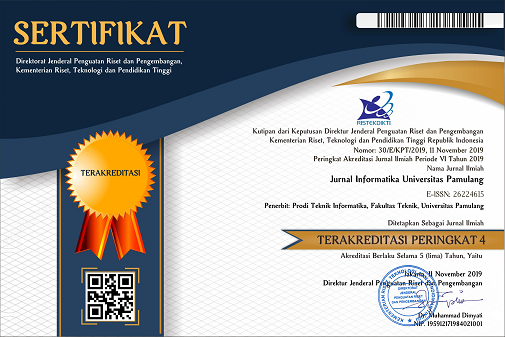Anonimisasi Data Penjualan Pakaian di Toko Online Menggunakan Metode K-Anonymity, L-Diversity, dan T-Closeness
DOI:
https://doi.org/10.32493/informatika.v6i2.9161Keywords:
Anonymization, K-anonymity, l-diversity, t-closeness, MondrianAbstract
The development of information technology will have an impact on the development of data. The existence of data might contain sensitive elements that are not intended to become public consumers. Anonymization is a technique that can be applied in publishing data with a different identity or anonymously. K-anonymity is an approach that can anonymization data. Besides that, the l-diversity and t-closeness approaches are also one of the advanced alternatives in data anonymization. The Mondrian algorithm can be implemented in k-anonymity. Therefore, we use the Mondrian algorithm for anonymizing clothing online transaction. The application of these methods can overcome the problem of data privacy contained in the dataset. The results obtained are that the application of the Mondrian algorithm in k-anonymity, l-diversity, and t-closeness has successfully performed data anonymization so that data cannot be consumed freely by other users.References
Hidayat, R., Premananda, I. G. A., & Rakhmawati, N. A. (2021). Dataset Penjualan Pakaian Menggunakan K-Anonymity (1.0) [Computer software]. Zenodo. https://doi.org/10.5281/ZENODO.4445564.
Frikken, K. B., & Zhang, Y. (2008). Yet another privacy metric for publishing micro-data. Proceedings of the 7th ACM Workshop on Privacy in the Electronic Society, 117–122.
LeFevre, K., DeWitt, D. J., & Ramakrishnan, R. (2006). Workload-aware Anonymization. KDD '06: Proceedings of the 12th ACM SIGKDD international conference on Knowledge discovery and data mining, pages 277–286.
Li, N., Li, T., & Venkatasubramanian, S. (2007). t-closeness: Privacy beyond k-anonymity and l-diversity. 2007 IEEE 23rd International Conference on Data Engineering, 106–115.
Machanavajjhala, A., Kifer, D., Gehrke, J., & Venkitasubramaniam, M. (2007). l-diversity: Privacy beyond k-anonymity. ACM Transactions on Knowledge Discovery from Data (TKDD), Vol. 1, No. 1, Article 3.
Nergiz, M. E., & Atzori, M. (2009). Towards Trajectory Anonymization: A Generalization-Based Approach. SPRINGL '08: Proceedings of the SIGSPATIAL ACM GIS 2008 International Workshop on Security and Privacy in GIS and LBS, pages 52–61.
Rule, A., Tabard, A., & Hollan, J. D. (2018). Exploration and explanation in computational notebooks. Proceedings of the 2018 CHI Conference on Human Factors in Computing Systems, 1–12.
Samarati, P. (2001). Protecting respondents Privacy in Microdata release. IEEE TransacY Tions on Knowledge and Data Engineering, vol. 13, no. 6, pp. 1010-1027.
Sweeney, L. (2002). K-Anonymity: A Model For Protecting Privacy. International Journal of Uncertainty, Fuzziness and Knowledge-Based Systems, 10(05), 557–570. https://doi.org/10.1142/S0218488502001648.
Sya’airillah, S., & Adhi, B. P. (2020). Analisis Model L-Diversity Dengan Algoritma Systematic Clustering Dan Datafly. PINTER: Jurnal Pendidikan Teknik Informatika Dan Komputer, 4(1), 43–48.
Williams, D. P. (2018). The Mondrian Detection Algorithm for Sonar Imagery. IEEE Transactions on Geoscience and Remote Sensing, 56(2), 1091–1102, https://doi.org/10.1109/TGRS.2017.2758808.
Yousra, S. A., & Mazleena, S. (2018). A new heuristic anonymization technique for privacy preserved datasets publication on cloud computing. Journal of Physics: Conference Series, 1003(1), 012030.
Downloads
Published
Issue
Section
License
Authors who publish with this journal agree to the following terms:
- Authors retain copyright and grant the journal right of first publication with the work simultaneously licensed under a Creative Commons Attribution-NonCommercial 4.0 International (CC BY-NC 4.0) that allows others to share the work with an acknowledgement of the work's authorship and initial publication in this journal.
- Authors are able to enter into separate, additional contractual arrangements for the non-exclusive distribution of the journal's published version of the work (e.g., post it to an institutional repository or publish it in a book), with an acknowledgement of its initial publication in this journal.
- Authors are permitted and encouraged to post their work online (e.g., in institutional repositories or on their website) prior to and during the submission process, as it can lead to productive exchanges, as well as earlier and greater citation of published work (See The Effect of Open Access).
Jurnal Informatika Universitas Pamulang have CC-BY-NC or an equivalent license as the optimal license for the publication, distribution, use, and reuse of scholarly work.
In developing strategy and setting priorities, Jurnal Informatika Universitas Pamulang recognize that free access is better than priced access, libre access is better than free access, and libre under CC-BY-NC or the equivalent is better than libre under more restrictive open licenses. We should achieve what we can when we can. We should not delay achieving free in order to achieve libre, and we should not stop with free when we can achieve libre.
Jurnal Informatika Universitas Pamulang is licensed under a Creative Commons Attribution-NonCommercial 4.0 International (CC BY-NC 4.0)
YOU ARE FREE TO:
- Share : copy and redistribute the material in any medium or format
- Adapt : remix, transform, and build upon the material for any purpose, even commercially.
- The licensor cannot revoke these freedoms as long as you follow the license terms





